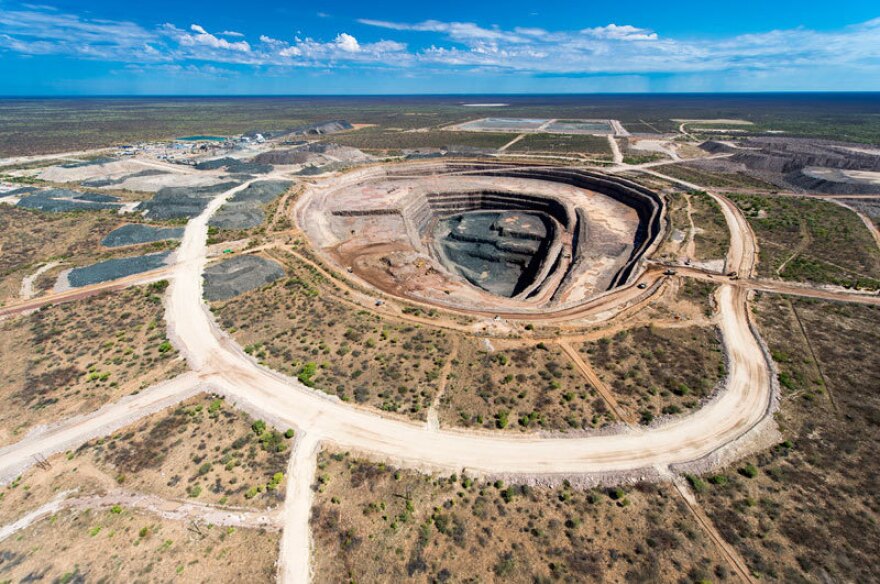Updated June 29 at 3:14 p.m.
Today Sotheby's attempted to auction the largest diamond discovered in over a century — a hunk of transparent rock the size of a tennis ball. It was found last November at an open-pit mine in the southern African country of Botswana. At 1,109 carats it's second in size only to the storied "Cullinan" diamond found in South Africa in 1905 and cut down into nine of the gems in the United Kingdom's Crown Jewels.
This new, rough diamond has been given its own name too — picked from among thousands of entries submitted by Botswana's citizens in a contest. They're calling it the "Lesedi La Rona" — which means "Our Light" in Botswana's official language of Tswana. It was valued at $70 million.
After bidding failed to reach a confidential reserve price, the company that operates the mine, Lucara Diamond Corp., announced that it would be holding on to the diamond for now.
Still, Lucara, which is Canadian and an otherwise minor player in the industry compared to big boys like De Beers Group, has been doing well. The same week it found the Lesedi La Rona, it uncovered two other giant diamonds nearby. These included the world's sixth largest gem-quality diamond — an 813 carat rough that Lucara auctioned off in May for the record-breaking sum of $63 million.
But what about Botswana — one of the world's biggest suppliers of rough diamonds? How much do sales like this benefit the country?
After all, in many parts of Africa, the discovery of diamonds hasn't been a blessing. The history of the diamond industry has been fraught with worker exploitation, environmental destruction, government corruption and squandering of revenues. And that's not even mentioning all the "blood diamonds" used to pay for civil wars in countries ranging from Sierra Leone to the Democratic Republic of Congo.
Yet Botswana's diamond story is different, notes Keith Jefferis, an economist and former deputy governor of Botswana's Central Bank. "I sometimes class Botswana's history over the last 40 years as well-managed good luck," he says.
The good luck part ironically began with the fact that when it was still a British protectorate, Botswana was thought to have virtually no natural resources.
"While the British were running the country it really was seen as a not very useful backwater," says Jefferis. "This, on the one hand, meant that not much money was spent on developing infrastructure. But it also meant that there wasn't a particularly big interest in keeping control."
The consequently smooth political transition to independence in 1966 helped ensure that Botswana's new government was stable and comparatively well-run.
A year later, diamonds were discovered in Botswana. But even then, notes Jefferis, "It still took quite some time before it was realized that the diamond deposits were actually quite valuable."
In the meantime, the fledgling government assumed it would have almost no natural resources to draw on. So it set itself up to focus as efficiently as possible on just a few priorities.
"To be honest because there had been very little development during the colonial era, it was pretty obvious what needed to be done," says Jefferis.

The priorities included investing in schools, roads, and getting water into people's homes and farms. As a result, once the diamond money did start rolling in there was a strong political consensus — which largely remains in effect today — that it should only be used for spending on these concerns.
"The principle," says Jefferis, "was that all the revenues from what essentially amounted to a depletion of an asset — [namely Botswana's diamonds] — had to be reinvested in other assets, so that mining wouldn't lead to an overall depletion of the national assets." In other words, invest in people and projects that will create future wealth.
Another bit of luck, says Jefferis: Botswana's diamonds aren't the alluvial kind — spread out in shallow mud across vast territories that are hard to secure. In Botswana the gems are deep in the ground.
"So just physically it's easy to manage access to where the diamonds are."
The government decided to use that control to negotiate some very favorable deals with private mining companies. This wasn't exactly easy. The need for the expertise of private mining companies seemed clear based on the experience of neighboring African countries that had nationalized their mines with less than stellar results. But Botswana's officials also appreciated that they might be at a disadvantage bargaining with mining executives who would be far more knowledgeable about the industry.
"Obviously if you're sitting across the table from a multinational mining company that has resources to bring in all sorts of experts, you need to have the same," says Jefferis. "So the government also made sure that if it needed a top London mining lawyer to help build its case it would do that to make sure that it could match the resources that the mining company would have on the other side of the table."
The actual arrangements have varied over the years, but the upshot is that Botswana shares joint ownership of the most important mines with De Beers in a setup that guarantees it the lion's share of the profits. Botswana has also set up a progressive taxation system under which other mining companies are taxed at higher rates when they get windfalls.
It's hard to overstate the impact of all this on Botswana's roughly 2 million citizens. The percentage of citizens living at or below poverty declined from 50 percent at independence to its current level of about 19 percent today. And incomes rose so fast that by 1990 Botswana was reclassified from a low-income country to a middle income one, with average incomes of around $7,240 per person.
Then came the HIV/AIDS crisis.
Joy Phumpahi was Botswana's health minister in the late 1990s and early 2000s. She describes how all these Batswana who had become teachers and accountants and other professionals suddenly started dying off.
"It was extremely frightening. We could actually see the gains that we had made over the years disappearing."
But Phumpahi says that Botswana's practice of using its diamond money for public investment made it that much easier for her to persuade the government to back an unprecedented plan.
Essentially it would buy HIV/AIDS drugs for every citizen who was infected.
Phumaphi stresses that this wasn't easy. It required redirecting resources away from other pressing needs. And Botswana still struggles — more than 1 in 5 adults lives with the disease. Still, the approach is widely credited with bringing the country back from the brink of disaster. And the model is one that major funders including the U.S. government and the Gates Foundation ultimately adapted to fight AIDS across Africa.
"That is what made us proud," says Phumaphi. "Not just that we were able to save Botswana. But that we were able to set an example that could be used to save the rest of the world."
And yet today there's concern that diamonds are still the only big industry Botswana has. It accounts for such a disproportionate share of the budget — 35 percent in 2016 — that "it's sort of the Achilles heel of the economy," says Jefferis.

There have been estimates that the diamonds could eventually run out. But even if they don't, diamond mining doesn't actually create a lot of jobs. And with its tiny population and few other resources, Botswana has found it hard to stimulate the creation of other more labor-intensive industries. As a result an enormous share of educated Batswana are employed by the government, unemployment hovers at just under 20 percent, and the country is among those ranked highest in the world when it comes to income inequality between the rich and poor.
These include the traditional hunter-gatherer Bushman communities. Indeed the group Survival International has charged that the government in conjunction with the diamond mining industry has pushed many of these tribesmen off their land and at times subjected them to arrest and torture.
Like many, Jefferis is hopeful Botswana will do more to diversify the economy by promoting alternative industries from coal to tourism. But he says he is worried: Because that "well-managed good luck" got Botswana to where it is today, "it essentially means that Botswana got to this status without really having to earn the income. OK, it had the challenge of not blowing it — you know, not wasting the proceeds."
Getting to the next economic level, he says, making the country competitive in other industries — that is a going to be a much bigger challenge. But as today proved, so, it would appear, is selling a legendarily large diamond.
Copyright 2023 NPR. To see more, visit https://www.npr.org.








